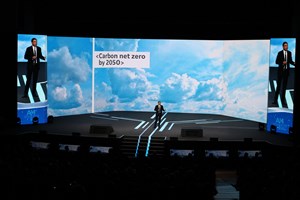BHGE to reduce CO2-equivalent emissions to net zero by 2050

FLORENCE, ITALY -- On the first day of its 20th annual meeting in Florence, Italy, Baker Hughes, a GE company has announced its commitment to reduce its CO2 equivalent emissions 50% by 2030,* achieving net-zero CO2 equivalent emissions by 2050. The company also said it will invest in its portfolio of advanced technologies to assist customers with reducing their carbon footprint.
Net zero carbon emissions
BHGE has already achieved a 26% reduction in its emissions since 2012 through a commitment to new technology and operational efficiencies. BHGE will continue to employ a broad range of emissions reduction initiatives across manufacturing, supply chain, logistics, energy sourcing and generation. BHGE has established a global additive manufacturing technology network with a mission to bring commercial-scale production closer to customers, reducing transportation impact and associated emissions.
“Oil and gas will continue to be an important part of the global energy mix, and BHGE is committed to investing in smarter technologies to advance the energy industry for the long-term,” said Lorenzo Simonelli, chairman and CEO of BHGE. “Managing carbon emissions is an important strategic focus for our business. We believe we have an important role to play as an industry leader and partner. BHGE has a long legacy of pushing the boundaries of technology and operating efficiency. Today, we take this to the next level by committing to ambitious new goals for ourselves, and to providing lower carbon solutions expected by customers and society.”
New carbon management practice
To further industry and customer efforts to reduce carbon emissions, BHGE’s Gaffney, Cline and Associates has launched a new Carbon Management Practice. This is the first oil and gas consultancy to offer quantitative assessment of carbon intensity, evaluation of carbon solutions and the accreditation of emission reductions. This new practice helps governments, energy companies and the financial community understand and solve energy transition issues related to oil and gas resources, assets and investments.
Technology partner to customers
At its annual meeting, BHGE announced new and existing technologies that support operators’ efforts to reduce their carbon footprint:
- LUMEN, a full-suite of methane monitoring and inspection solutions capable of streaming live data from sensors to a cloud-based software dashboard for real-time results. The platform consists of two seamlessly connected formats – a ground-based solar-powered wireless sensor network, and a drone-based system for over-air monitoring – ensuring methane emissions rates and concentration levels are monitored and located as efficiently and accurately as possible. This builds on BHGE’s extensive portfolio of remote inspection and sensing technologies.
- An agreement with H2U, Australia’s leading Hydrogen infrastructure developer, to configure BHGE’s NovaLT gas turbine generator technology to operate 100% on hydrogen for the Port Lincoln Project, a green hydrogen power plant facility in South Australia.
The new technologies build on BHGE’s expanding lower-carbon technology portfolio, which includes:
- Modular gas processing: Modular gas processing at Nassiriya and Al Gharraf oilfields in Iraq will recover 200 MMscmd of flare gas, reducing emissions by 5.7 MMmt/year of CO2 equivalent, and monetizing the recovered gas. The recovered gas will be processed into dry gas, liquefied petroleum gas for cooking, and condensate, and will support domestic power generation as well as exports. An additional net 3.9 MMmt of CO2 equivalent emissions reductions are possible annually if incremental power generation is fueled by natural gas, displacing oil. Flare gas recovery and use represents one of the largest emission reduction opportunities in the global oil & industry.
- LM9000 gas turbine: BHGE’s most advanced aeroderivative gas turbine, introduced in 2017, was designed to allow the LNG train startup in the pressurized condition without venting process gas. Its flexible fuel technology reduces emissions while eliminating water use in emissions abatement. The LM9000 delivers a 50% longer maintenance interval, 20% more power and 40% lower NOx emissions, resulting in 20% lower cost of ownership for LNG customers.
- Integrated compressor line: This high efficiency offshore compressor operates with zero emissions. It is driven by a high-speed electric motor in a single sealed casing and its rotor is levitated by active magnetic bearings (AMBs), allowing exceptional efficiency and reliability.
- flare.iQ: flare.IQ provides highly accurate, near-continuous control of downstream flare performance by optimizing combustion efficiency, allowing operators to reduce flaring-related emissions by up to 12,100 Mt of CO2 equivalent per flare annually. If deployed globally, flare.iQ could reduce annual emissions by 190 MMmt of CO2 equivalent.
- NextSource modular CO2 capture: NextSource converts thermal energy from rich burn Waukesha engine exhaust to provide low cost CO2 for oil and gas consumers. In the process, each four-engine pad reduces emissions by 16,200 Mt of CO2 equivalent annually or 60% compared to the no-capture scenario. In addition, because CO2 is captured near the well site, emissions are avoided from not having to transport liquid CO2 from a remote location to the well site.
**BHGE’s 2030 emissions reduction targets and performance are based on scope 1 & 2 emissions for 2017 and baseline year 2012, as reported to the Carbon Disclosure Project.


